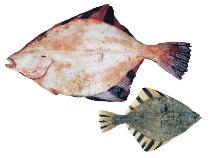| Family: |
Pleuronectidae (Righteye flounders), subfamily: Pleuronectinae |
| Max. size: |
91 cm TL (male/unsexed); max.weight: 9,100.0 g; max. reported age: 42 years |
| Environment: |
demersal; freshwater; brackish; marine; depth range 0 - 375 m, catadromous |
| Distribution: |
Northern Pacific, from the Yellow Sea along coasts of Korean Peninsula, Russian Far East, and Japanese Arch. to the Arctic, including Chukchi and Beaufort seas, extending to the south through the Bering Sea to California. |
| Diagnosis: |
Dorsal spines (total): 0-0; Dorsal soft rays (total): 52-66; Anal spines: 1-1; Anal soft rays: 38-47; Vertebrae: 34-37. Distinguished by the presence of both eyes on the same side of the head, dorsal and anal fins that are marked with dark and light (white to orange) bars, and especially, by the stellate, bony tubercles scattered over its body (Ref. 27547). Dorsal originates over middle of upper eye; anal with a sharp, forward pointing spine (often buried in skin) before first ray; pectorals are bluntly pointed; caudal slightly rounded (Ref. 27547). Eyed side dark brown to nearly black, sometimes with indefinite blotchings (Alaskans specimens sometimes with a greenish tinge); blind side white to creamy; dorsal fin with 4 to 7 dark bars with white to orange spaces between; anal fin with 4 to 6 such bars; caudal fin with 3 or 4 dark longitudinal bars on its posterior part; in rare cases, the blind side may be partly or completely colored like the eyed side, or white may be present on the eyed side, creating a piebald effect (Ref. 27547, 28897, 28898). |
| Biology: |
Found inshore, often in very shallow water and in estuaries during the summer; moving into deeper water in the winter (Ref. 27547). However, they may occur in deep water throughout the year (Ref. 27547). Does not venture into water of high salinities (Ref. 28899). Young and adults move up rivers, as much as 120 km (Ref. 27547). Benthic (Ref. 58426). Feeds on crustaceans, worms, small mollusks, brittle stars, and small fishes (Ref. 6885). Important game fish (Ref. 2850). Utilized fresh and frozen; eaten steamed, fried, boiled, microwaved, and baked (Ref. 9988). |
| IUCN Red List Status: |
Least Concern (LC); Date assessed: 05 November 2020 Ref. (130435)
|
| Threat to humans: |
harmless |
Source and more info: www.fishbase.org. For personal, classroom, and other internal use only. Not for publication.
